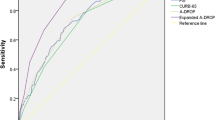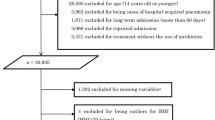Abstract
OBJECTIVE: To see whether predictions of patients’ likelihood of dying in-hospital differed among severity methods.
DESIGN: Retrospective cohort.
PATIENTS: 18,016 persons 18 years of age and older managed medically for pneumonia; 1,732 (9.6%) in-hospital deaths.
METHODS: Probability of death was calculated for each patient using logistic regression with age, age squared, sex, and each of five severity measures as the independent variables: 1) admission MedisGroups probability of death scores; 2) scores based on 17 admission physiologic variables; 3) Disease Staging’s probability of mortality model; the Severity Score of Patient Management Categories (PMCs); 4) and the All Patient Refined Diagnosis-Related Groups (APR-DRGs). Patients were ranked by calculated probability of death; 5) rankings were compared across severity methods. Frequencies of 14 clinical findings considered poor prognostic indicators in pneumonia were examined for patients ranked differently by different methods.
RESULTS: MedisGroups and the physiology score predicted a similar likelihood of death for 89.2% of patients. In contrast, the three code-based severity methods rated over 25% of patients differently by predicted likelihood of death when compared with the rankings of the two clinical data-based methods (MedisGroups and the physiology score). MedisGroups and the physiology score demonstrated better clinical credibility than the three severity methods based on discharge abstract data.
CONCLUSIONS: Some pairs of severity measures ranked over 25% of patients very differently by predicted probability of death. Results of outcomes studies may vary depending on which severity method is used for risk adjustment.
Similar content being viewed by others
References
United States General Accounting Office; Health, Education, and Human Services Division. Health care reform. “Report cards” are useful but significant issues need to be addressed. GAO/HEHS-94-219. Washington, DC: United States General Accounting Office, 1994.
United States General Accounting Office; Health, Education, and Human Services Division. Employers urge hospitals to battle costs using performance data. GAO/HEHS-95-1. Washington, DC: United States General Accounting Office, 1994.
Iezzoni LI, Shwartz M, Restuccia J. The role of seventy information in health policy debates: a survey of state and regional concerns. Inquiry. 1991;28:117–28.
Iezzoni LI, Greenberg LG. Widespread assessment of risk-adjusted outcomes: lessons from local initiatives. Joint Comm J Qual Improv. 1994;20:305–16.
Localio AR, Hamory BH, Sharp TJ, Weaver SL, TenHave TR, Landis JR. Comparing hospital mortality in adult patients with pneumonia. A case study of statistical methods in a managed care program. Ann Intern Med. 1995;122:125–32.
Epstein A. Performance reports on quality—prototypes, problems, and prospects. N Engl J Med. 1995;333:57–61.
Selker HP. Systems for comparing actual and predicted mortality rates: characteristics to promote cooperation in improving hospital care. Ann Intern Med. 1993;118:820–2.
Kassirer JP. The use and abuse of practice profiles. N Engl J Med. 1994;330:634–6.
U.S. Congress, Office of Technology Assessment. Identifying health technologies that work: searching for evidence. OTA-H-608. Washington. DC: U.S. Government Printing Office, 1994.
McMahon LF, Billi JE. Measurement of severity of illness and the Medicare prospective payment system: state of the art and future directions. J Gen Intern Med. 1988;3:482–90.
The Quality Measurement and Management Project. The Hospital Administrator’s Guide to Severity Measurement Systems. Chicago: The Hospital Research and Educational Trust of the American Hospital Association, 1989.
Iezzoni LI, ed. Risk Adjustment for Measuring Health Care Outcomes. Ann Arbor, MI: Health Administration Press, 1994.
Iezzoni LI. Black box’ medical information systems: a technology needing assessment. JAMA. 1991;265:3006–7.
Iezzoni LI. Dimensions of risk. In: Iezzoni LI, ed. Risk Adjustment for Measuring Health Care Outcomes. Ann Arbor, MI: Health Administration Press. 1994;29–118.
U.S. Department of Health, Education and Welfare: National Committee on Vital and Health Statistics. Uniform Hospital Discharge Data Minimum Data Set. DHWQ Pub. No (PHS) 80-1157. Hyattsville, MD: U.S. Department of Health, Education and Welfare, 1980.
Iezzoni LI. Data sources and implications: administrative data bases. In: Iezzoni LI, ed. Risk Adjustment for Measuring Health Care Outcomes. Ann Arbor, MI: Health Administration Press, 1994;119–75.
Brewster AC, Karlin BG, Hyde LA, Jacobs CM, Bradbury RC, Chae YM. MEDISGRPS: a clinically based approach to classifying hospital patients at admission. Inquiry. 1985;12:377–87.
Iezzoni LI, Moskowitz MA. A clinical assessment of MedisGroups. JAMA. 260:3159–63.
Steen PM, Brewster AC. Bradbury RC. Estabrook E. Young JA. Predicted probabilities of hospital death as a measure of admission severity of illness. Inquiry. 1993;30:128–41.
Knaus WA, Wagner DP, Draper EA, et al. The APACHE III prognostic system: risk prediction of hospital mortality for critically ill hospitalized adults. Chest. 1991;100:1619–36.
Knaus WA, Wagner DP, Zimmerman JE, Draper EA. Variations in mortality and length of stay in intensive care units. Ann Intern Med. 1993;118:753–61.
Gonnella JS, Hombrook MC, Louis DZ. Staging of disease: a case-mix measurement. JAMA. 1984;251:637–44.
Markson LE. Nash DB, Louis DZ, Gonnella JS. Clinical outcomes management and disease staging. Eval Health Prof. 1991;14:201–27.
Young WW, Kohler S, Kowalski J. PMC patient severity scale: derivation and validation. Health Serv Res. 1994;29:367–90.
All Patient Refined Diagnosis Related Groups: Definition Manual. Wallingford. CT: 3M Health Information Systems, 1993.
Edwards N, Honemann D, Burley D, Navarro M. Refinement of Medicare diagnosis-related groups to incorporate a measure of severity. Health Care Fin Rev. 1994;16:45–64.
Iezzoni LI, Shwartz M, Ash AS, Hughes JS, Daley J, Mackiernan YD. Severity measurement methods and predicting pneumonia deaths. Med Care (in press).
Iezzoni LI, Hotchkin EK, Ash AS, Shwartz M, Mackiernan Y. Me-disGroups databases: the impact of data collection guidelines on predicting in-hospital mortality. Med Care. 1993;31:277–83.
Knaus WA, Draper EA, Wagner DP, Zimmerman JE. APACHE II: a severity of disease classification system. Crit Care Med. 1985;13:818–29.
Harrell FE, Lee KL, Califf RM, Pryor DB, Rosati RA. Regression modelling strategies for improved prognostic prediction. Stat Med. 1984;3:143–52.
Hanley JA, McNeil BJ. The meaning and use of the area under a receiver operating characteristic (ROC) curve. Radiology. 1982;143:29–36.
Hanley JA, McNeil BJ. A method of comparing the area under receiver operating characteristic curves derived from the same cases. Radiology. 1983;148:839–43.
Daley J. Validity of risk-adjustment methods. In: Iezzoni LI, ed. Risk Adjustment for Measuring Health Care Outcomes. Ann Arbor, MI: Health Administration Press, 1994;254.
Fine EM, Hanusa BH, Lave JR, et al. Comparison of severity of illness measures in patients with community acquired pneumonia. J Gen Intern Med. 1995;10:359–68.
Daley J, Jencks S, Draper D, Lenhart G, Thomas N, Walker J. Predicting hospital-associated mortality for Medicare patients: a method for patients with stroke, pneumonia, acute myocardial infarction and congestive heart failure. JAMA. 1988;260:3622–4.
Iezzoni LI, Foley SM, Heeren T, et al. A method for screening the quality of hospital care using administrative data: preliminary validation results. Qual Rev Bull. 1992;18:361–71.
Shapiro MF, Park RE, Keesey J, Brook RH. The effect of alternative case-mix adjustments on mortality differences between municipal and voluntary hospitals in New York City. Health Serv Res. 1994;29:95–112.
Iezzoni LI, Shwartz M, Ash AS, et al. Evaluating Severity Adjustors for Patient Outcome Studies. Final Report. Beth Israel Hospital, Boston, May 10, 1995. Prepared for the Agency for Health Care Policy and Research under grant RO1-HS06742.
Iezzoni LI, Ash AS, Shwartz M, Daley J, Hughes JS, Mackieman YD. Predicting who dies depends on how severity is measured: implications for evaluating patient outcomes. Ann Intern Med 1995;123:763–70.
Jencks SF, Williams DK, Kay TL. Assessing hospital-associated deaths from discharge data: the role of length of stay and comorbidities. JAMA. 1988;260:2240–6.
Author information
Authors and Affiliations
Additional information
Supported by the Agency for Health Care Policy and Research, under grant RO1 HS06742-03. The views expressed are solely those of the authors.
Rights and permissions
About this article
Cite this article
Iezzoni, L.I., Shwartz, M., Ash, A.S. et al. Using severity measures to predict the likelihood of death for pneumonia inpatients. J Gen Intern Med 11, 23–31 (1996). https://doi.org/10.1007/BF02603481
Issue Date:
DOI: https://doi.org/10.1007/BF02603481




